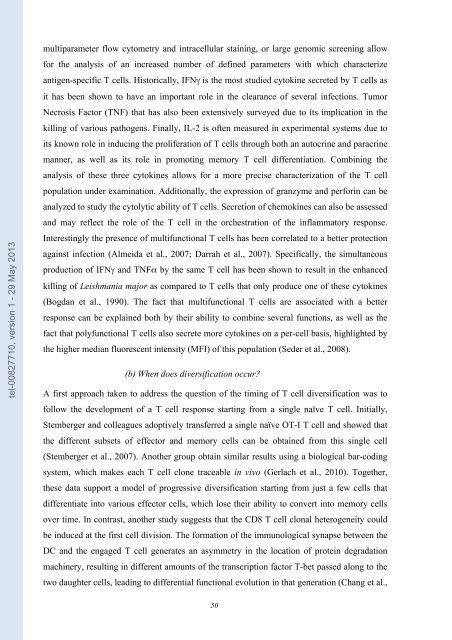Voie d'immunisation et séquence d'administration de l ... - TEL
Voie d'immunisation et séquence d'administration de l ... - TEL
Voie d'immunisation et séquence d'administration de l ... - TEL
Create successful ePaper yourself
Turn your PDF publications into a flip-book with our unique Google optimized e-Paper software.
tel-00827710, version 1 - 29 May 2013<br />
multiparam<strong>et</strong>er flow cytom<strong>et</strong>ry and intracellular staining, or large genomic screening allow<br />
for the analysis of an increased number of <strong>de</strong>fined param<strong>et</strong>ers with which characterize<br />
antigen-specific T cells. Historically, IFNγ is the most studied cytokine secr<strong>et</strong>ed by T cells as<br />
it has been shown to have an important role in the clearance of several infections. Tumor<br />
Necrosis Factor (TNF) that has also been extensively surveyed due to its implication in the<br />
killing of various pathogens. Finally, IL-2 is often measured in experimental systems due to<br />
its known role in inducing the proliferation of T cells through both an autocrine and paracrine<br />
manner, as well as its role in promoting memory T cell differentiation. Combining the<br />
analysis of these three cytokines allows for a more precise characterization of the T cell<br />
population un<strong>de</strong>r examination. Additionally, the expression of granzyme and perforin can be<br />
analyzed to study the cytolytic ability of T cells. Secr<strong>et</strong>ion of chemokines can also be assessed<br />
and may reflect the role of the T cell in the orchestration of the inflammatory response.<br />
Interestingly the presence of multifunctional T cells has been correlated to a b<strong>et</strong>ter protection<br />
against infection (Almeida <strong>et</strong> al., 2007; Darrah <strong>et</strong> al., 2007). Specifically, the simultaneous<br />
production of IFNγ and TNFα by the same T cell has been shown to result in the enhanced<br />
killing of Leishmania major as compared to T cells that only produce one of these cytokines<br />
(Bogdan <strong>et</strong> al., 1990). The fact that multifunctional T cells are associated with a b<strong>et</strong>ter<br />
response can be explained both by their ability to combine several functions, as well as the<br />
fact that polyfunctional T cells also secr<strong>et</strong>e more cytokines on a per-cell basis, highlighted by<br />
the higher median fluorescent intensity (MFI) of this population (Se<strong>de</strong>r <strong>et</strong> al., 2008).<br />
(b) When does diversification occur?<br />
A first approach taken to address the question of the timing of T cell diversification was to<br />
follow the <strong>de</strong>velopment of a T cell response starting from a single naïve T cell. Initially,<br />
Stemberger and colleagues adoptively transferred a single naïve OT-I T cell and showed that<br />
the different subs<strong>et</strong>s of effector and memory cells can be obtained from this single cell<br />
(Stemberger <strong>et</strong> al., 2007). Another group obtain similar results using a biological bar-coding<br />
system, which makes each T cell clone traceable in vivo (Gerlach <strong>et</strong> al., 2010). Tog<strong>et</strong>her,<br />
these data support a mo<strong>de</strong>l of progressive diversification starting from just a few cells that<br />
differentiate into various effector cells, which lose their ability to convert into memory cells<br />
over time. In contrast, another study suggests that the CD8 T cell clonal h<strong>et</strong>erogeneity could<br />
be induced at the first cell division. The formation of the immunological synapse b<strong>et</strong>ween the<br />
DC and the engaged T cell generates an asymm<strong>et</strong>ry in the location of protein <strong>de</strong>gradation<br />
machinery, resulting in different amounts of the transcription factor T-b<strong>et</strong> passed along to the<br />
two daughter cells, leading to differential functional evolution in that generation (Chang <strong>et</strong> al.,<br />
50

















